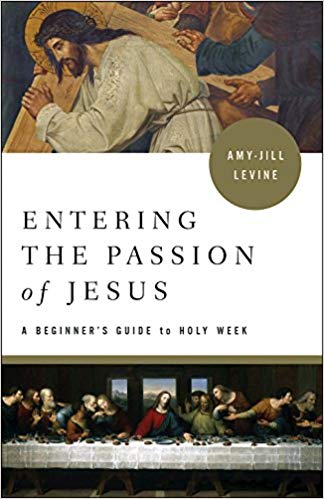A-J. LEVINE, ENTERING THE PASSION OF JESUS. A BEGINNER’S GUIDE TO HOLY WEEK, (ABINGDON 2018), 143 PAGES, PLUS DVD WITH SESSIONS FOR EACH CHAPTER, AND A LEADER’S GUIDE.
There are, of course, many resources for studying the events of Holy Week, from the triumphal entry to the crucifixion but few if any of them are as interesting and probing and creative as A-J Levine’s latest offering entitled Entering the Passion of Jesus. Levine is a leading NT scholar and professor at Vanderbilt, with particular expertise in the Gospels and in historical Jesus studies (see her best-selling book The Misunderstood Jew). Levine writes with sensitivity and understanding of the Gospel traditions, and in a manner that shows both respect and empathy for Christian readings of these stories, while at the same time offering her own fresh take on the stories, which sometimes challenges and sometimes confirms traditional readings of these vital stories about the end of Jesus’ life.
The book is not long, and is well written, divided up into six main chapters: 1) Jerusalem: Risking Reputation; 2) The Temple; Risking Righteous Anger; 3) Teachings; Risking Challenge; 4) The First Dinner: Risking Rejection; 5) The Last Supper: Risking the Loss of Friends; and Gethsemane: Risking Temptation. The alert reader will notice that while the book is entitled Entering the Passion of Jesus, it does not in fact deal with the crucifixion or Jesus’s last encounters and final sayings. While the book takes some risks, it does not take the big one of dealing with the enormous subject of the death of Jesus and its significance, perhaps wisely, since it would require a whole length study in itself.
One of the major strengths of Levine’s scholarship is that, not surprisingly, she brings her considerable knowledge not only of the OT, but also of the vast literature of early Judaism (and post-70 A.D. Judaism as well) to the task of interpreting the NT. This is something which few NT scholars have equal skill in or knowledge of, and in each of the six chapters we see the fruit of such an approach. We also see Levine’s pastoral skills of drawing analogies with modern human experiences, and showing how the ‘old old story of Jesus and his love’ relates in powerful and poignant ways to the contemporary experiences of Christians and Jews and others.
Of course there are some places where Prof. Levine and I would disagree on the interpretation of this or that part of these Passion Week traditions, but there are also various places where I found myself saying the Amen to her passionate readings of the text, or found myself saying—‘she may be right. I need to ponder that more’. It goes without saying that this book also helps us get beyond anti-Semitic or insensitive readings of these stories that denude Jesus and the disciples of their Jewishness, or caricature all the Jewish officials and authority figures as hypocrites or just plain wicked. I am happy to commend these resources to my readers on Patheos, and to Church-going folk everywhere. Re-reading these stories through the keen eyes of A-J Levine is both helpful and challenging. The question is— Will you take the risk?













